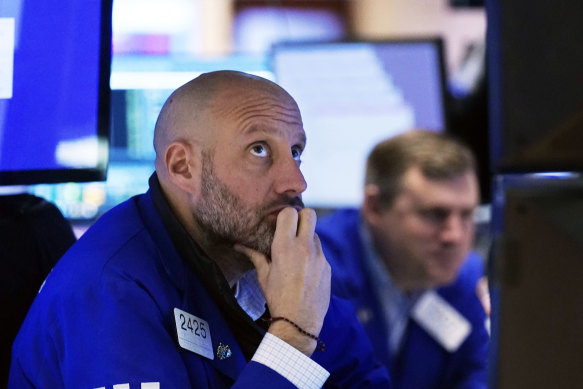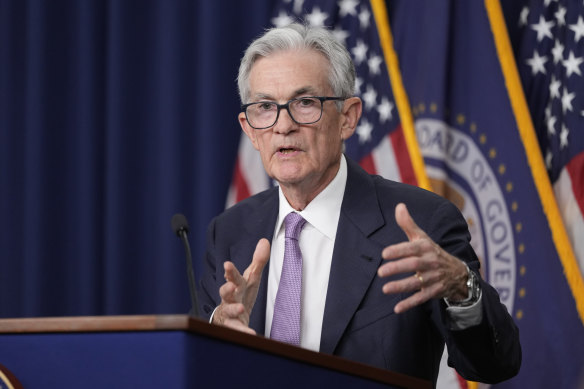This was published 9 months ago
Opinion
Why this famous recession predictor might be wrong this time
Stephen Bartholomeusz
Senior business columnistEarlier this month, the longest-recorded inversion of the US yield curve ended. Does that signal that a recession has been averted?
For more than half a century recessions have followed inversions of the yield curve in the US, where the yields on the shorter-dated Treasury securities climb above those on the longer-dated bonds.

The threat of a recession in the US is hanging over markets.Credit: AP
Inversions upend conventional investment theory, given that investors in the longer-dated government securities would normally expect to be compensated for having their funds locked away for longer periods. In effect, an inversion says that the short-term risks to the economy outweigh those in the longer term.
While not every inversion of the curve has been followed by a recession, every recession in the US has been preceded by one, hence the lengthy fascination with the latest inversion, which occurred back in early July 2022. It ended early this month after weaker-than-expected job numbers virtually locked in the Federal Reserve rate cut that occurred last week.
After the Fed’s half a percentage point cut to its policy rate, the federal funds rate, the spread between the yield on the US 10-year bond and two-year Treasury notes blew out to 15 basis points – the yield on the 10-year securities was 15 basis points higher than that on the two-year notes. Only a month earlier, the yield on two-year notes was 16 basis points higher than that of the 10-year bonds.
At face value, that would suggest that investors, convinced that the Fed will now aggressively push down interest rates now that inflation has subsided and is closing in on the Fed’s target of 2 per cent, are betting that a recession will be avoided and a soft landing for the economy achieved.
These are, however, unusual times and too much could be read into a single indicator.
Just as the curve remained inverted for more than two years without anything close to a recession developing, it might be premature to see the normalisation of the curve as a victory sign.
Indeed, while the curve inverted ahead of each of the six US recessions of the past half century, just ahead of four of those recessions the curve had normalised.
That may have been because the Fed’s monetary policies most affect short-term rates and, as was the case last week, the Fed was belatedly cutting rates to try (unsuccessfully in those instances) to avoid a recession.
For the pessimists, it is conceivable that the Fed has been “behind the curve” again in waiting until this month to cut rates. From that perspective, the size of the cut – 50 basis points rather than the more conventional and conservative 25 basis points – would be a belated recognition of rising recessionary risks.
The grounds for thinking that this time might be different to those four earlier episodes, however, lie in the settings of the US economy, which are relatively healthy.
The Fed’s projections last week see real GDP this year of 2 per cent and similar levels of growth through to the end of 2027 at least. An unemployment rate of 4.4 per cent this year and next does reflect a slight increase, but with unemployment still at historically low levels and not at a rate consistent with a recession.
Thus, while the Fed could be criticised for not moving a little earlier, the oversized nature of its first cut in this rate cycle appears more of a catch-up after waiting for reassurance that the inflation rate was under control than a signal of panic.
It might also be that the Fed is simply ironing out what has been an abnormal period for monetary policy.
The pandemic and the supply chain shocks it generated, and which caused the US inflation rate to spike above 9 per cent, were once-in-a-century or more events that have largely worked their way through economies around the world. As economic settings have normalised, monetary policies are tracking them.
The massive amounts of spending during and after the pandemic by the Trump and Biden administrations may have contributed to the surge in inflation but may now be cushioning the US economy and helping it to achieve, if the Fed finesses it, the hoped-for soft landing.
There is, of course, another set of considerations for bond investors that might encourage them to demand higher yields in return for the higher risks of holding longer-term securities.

Federal Reserve chairman Jerome Powell. Has the world’s leading central bank left it too late? Credit: AP
The US budget deficit has blown out to almost $US2 trillion ($2.9 trillion) and US government debt has surged through $US35 trillion with no agenda from either of the two major parties to reverse the trends.
That means a lot more government bonds hitting the market and putting upward pressure on yields, particularly those of longer-dated securities.
That’s occurring even as the Fed, once the largest buyer of government securities during its various bursts of quantitative easing (buying securities to inject liquidity into the financial system and economy), is now in quantitative tightening mode (allowing the securities it holds to mature without reinvesting the proceeds).
Even a cursory analysis of the policies that Donald Trump and Kamala Harris have rolled out in the lead up to the US elections in November reveals that, if anything, government spending, deficits and debt are likely to rise and rise significantly regardless of the election outcome.
Indeed, while the curve inverted ahead of each of the six US recession of the past half century, just ahead of four of those recessions the curve had normalised.
Trump, who thinks tariffs are the answer to every economic question and that income from massive increases in their rates can pay for everything for another big round of tax cuts for companies and wealthy households to removing the tax on tips and overtime, would, if the policies were implemented, preside over another big splurge and almost inevitably a new and significant outbreak of inflation that would force the Fed to raise rates again.
Harris, because she wouldn’t extend Trump’s 2017 tax cuts, which expire next year, could have more revenue to play with but, as has been the case with the Biden term, she also has a big-spending and potentially inflationary agenda.
With neither of the presidential candidates devoting any meaningful time to discussions of debt and deficits the likelihood is that they will continue to expand, as will the scale of issuance of the US government’s debt securities.
Thus, whatever the yield curve or Fed projections might look like today, they could be very different next year and beyond. That, regardless of whether a soft landing is in sight, would warrant stronger yields for the risks of holding anything other than short-term securities.
At the moment, depending on how it is interpreted, the normalisation of the yield curve might point to the odds favouring falling interest rates, particularly at the shorter end of the yield curve, and a soft landing.
The election could, however, usher in a period for the economy that is anything but normal, particularly (but not exclusively) if Trump, who has the more radical and disruptive agenda, prevails.
The Market Recap newsletter is a wrap of the day’s trading. Get it each weekday afternoon.